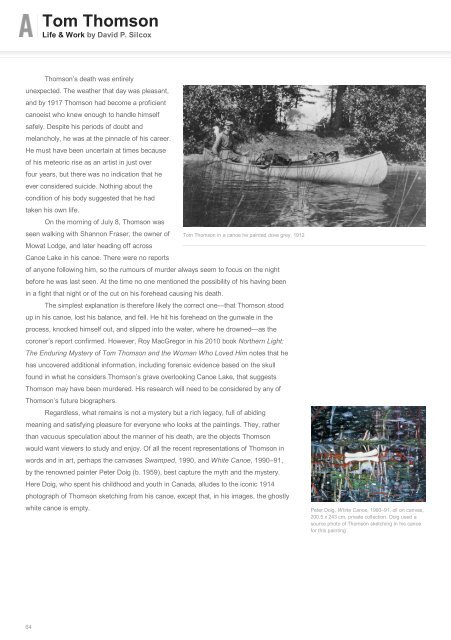You also want an ePaper? Increase the reach of your titles
YUMPU automatically turns print PDFs into web optimized ePapers that Google loves.
<strong>Tom</strong> <strong>Thomson</strong><br />
Life & Work by David P. Silcox<br />
<strong>Thomson</strong>’s death was entirely<br />
unexpected. The weather that day was pleasant,<br />
and by 1917 <strong>Thomson</strong> had become a proficient<br />
canoeist who knew enough to handle himself<br />
safely. Despite his periods of doubt and<br />
melancholy, he was at the pinnacle of his career.<br />
He must have been uncertain at times because<br />
of his meteoric rise as an artist in just over<br />
four years, but there was no indication that he<br />
ever considered suicide. Nothing about the<br />
condition of his body suggested that he had<br />
taken his own life.<br />
On the morning of July 8, <strong>Thomson</strong> was<br />
seen walking with Shannon Fraser, the owner of<br />
Mowat Lodge, and later heading off across<br />
Canoe Lake in his canoe. There were no reports<br />
<strong>Tom</strong> <strong>Thomson</strong> in a canoe he painted dove grey, 1912<br />
of anyone following him, so the rumours of murder always seem to focus on the night<br />
before he was last seen. At the time no one mentioned the possibility of his having been<br />
in a fight that night or of the cut on his forehead causing his death.<br />
The simplest explanation is therefore likely the correct one—that <strong>Thomson</strong> stood<br />
up in his canoe, lost his balance, and fell. He hit his forehead on the gunwale in the<br />
process, knocked himself out, and slipped into the water, where he drowned—as the<br />
coroner’s report confirmed. However, Roy MacGregor in his 2010 book Northern Light:<br />
The Enduring Mystery of <strong>Tom</strong> <strong>Thomson</strong> and the Woman Who Loved Him notes that he<br />
has uncovered additional information, including forensic evidence based on the skull<br />
found in what he considers <strong>Thomson</strong>’s grave overlooking Canoe Lake, that suggests<br />
<strong>Thomson</strong> may have been murdered. His research will need to be considered by any of<br />
<strong>Thomson</strong>’s future biographers.<br />
Regardless, what remains is not a mystery but a rich legacy, full of abiding<br />
meaning and satisfying pleasure for everyone who looks at the paintings. They, rather<br />
than vacuous speculation about the manner of his death, are the objects <strong>Thomson</strong><br />
would want viewers to study and enjoy. Of all the recent representations of <strong>Thomson</strong> in<br />
words and in art, perhaps the canvases Swamped, 1990, and White Canoe, 1990–91,<br />
by the renowned painter Peter Doig (b. 1959), best capture the myth and the mystery.<br />
Here Doig, who spent his childhood and youth in Canada, alludes to the iconic 1914<br />
photograph of <strong>Thomson</strong> sketching from his canoe, except that, in his images, the ghostly<br />
white canoe is empty.<br />
Peter Doig, White Canoe, 1990–91, oil on canvas,<br />
200.5 x 243 cm, private collection. Doig used a<br />
source photo of <strong>Thomson</strong> sketching in his canoe<br />
for this painting<br />
64


